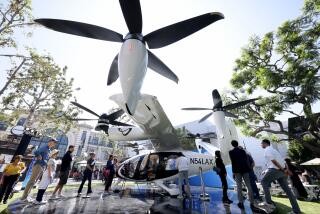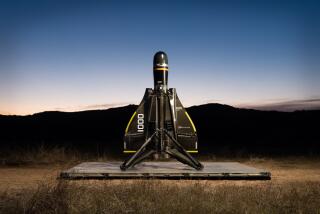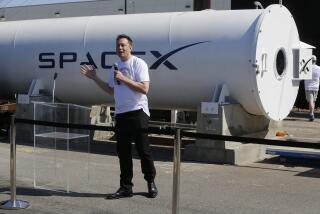Global warming may kill the new era of supersonic travel before it even begins
- Share via
The dream of flying passengers faster than the speed of sound gave birth to Concorde in the 1970s, only for the nightmare of making a profit to snuff it out less than three decades later.
Companies competing to build a successor to the iconic jet may find that the biggest hurdle isn’t technology or economics, but the hefty carbon footprint that’s the result of such eye-watering speeds — especially with mainstream plane and engine makers saying electric airliners may soon be within reach.
Driven by mounting public and political concerns about aviation emissions, the newfound environmental zeal of manufacturers such as Airbus threatens to make start-ups intent on breaking the sound barrier look like relics from a greedier age that spared little thought for the environment. That’s despite advances in aerodynamic design, materials and propulsion that have brought a second supersonic era tantalizingly close.
Those concerns were on display at last week’s Paris Air Show, where Boom Technology Inc., which is working to introduce a 75-seat, Mach 2.2 jetliner, went out of its way to assert the plane’s green credentials.
Founder and Chief Executive Blake Scholl revealed that an engine-testing program had tried out a high-concentration biofuel blend that proved to be 3% more efficient than traditional kerosene, then announced that Boom will partner with Prometheus Fuels, whose carbon-capture technology scrubs CO2 from the air and transforms it into liquid propellant.
Boom’s XB-1 demonstrator plane will “have history’s first zero net carbon footprint on a supersonic flight,” Scholl told an audience primed for news of dizzying speeds and thrust rather than a pitch on pollution.
“It’s important to do supersonic flight in a way that’s environmentally sustainable,” Scholl said. “It’s not good enough just to match the fuel efficiency and emission profile of current business class. We have to find a way to prove we are taking great care of the planet.”
Alternative fuels and measures such as carbon-offsetting don’t change the basic inefficiency of supersonic planes, says Dan Rutherford, program director for marine and aviation at the International Council on Clean Transportation. Their high speed, low passenger capacity, limited cargo space and refueling requirements for trans-oceanic flights would make the jets five to seven times as carbon intensive per passenger as subsonic aircraft, according to the think tank.
Carbon footprint aside, Boom’s vision of a supersonic future is certainly seductive.
Travel from New York to London and be home in time to tuck your children into bed. Fly San Francisco-Tokyo or Seattle-Shanghai a whole day later than now and still make a Monday morning meeting in Asia. Or speed between Hong Kong and the Japanese capital in just two hours. There’d be no lie-flat seats because you’d never need to sleep aboard.
Boom says its aircraft would have operating costs 75% lower than those of Concorde, making more than 500 routes across the planet viable from the outset, rather than just London to New York in the case of the Anglo-French jet, which was retired from service in 2003.
Yet the timeline mapped out by Scholl suggests that Boom — which boasts alumni of Airbus, Boeing Co., Lockheed Martin Corp. and NASA among its 150 staff members — could fly straight into the biggest revolution in aviation since the dawn of the jet age in the 1950s.
Rollout of the one-third scale XB-1 is due in December, with its first flight in 2020. But a fully fledged airliner won’t take to the air for several more years, and service entry might not come until 2027. By that point, the first generation of hybrid-electric narrow-body jets will be well into development, with commercial operations targeted for 2035, according to Airbus projections.
Airbus Chief Technology Officer Grazia Vittadini said the company is now “very close” to beginning the shift away from its reliance on jet fuel.
“It’s a societal lead and a business imperative, not just a technology challenge,” she said. “We really need to strive for zero-emission aviation. This is the ultimate ambition.”
There’s also evidence that consumer attitudes are evolving even faster than the technology, especially among the young, with a decline in air travel at Swedish airports and a parallel jump in rail travel attributed to the phenomenon of flygskam, or “flying shame.”
Boom has already had a taste of the sensitivities that surround supersonic travel, with the group name quietly dropped from the planned production aircraft, now dubbed the Overture, after referencing the sonic booms that caused Concorde to be limited to over-water flights was deemed unwise.
The noise issue remains, and Boom estimates of 1,000 to 2,000 orders (versus 14 Concordes) assume the plane won’t initially be able to operate over land.
Scholl said in an interview he takes the issue of changing public perceptions seriously, but that carriers are still clamoring to include a supersonic jet in their fleets.
“There isn’t an airline in the world that isn’t interested,” he said. “What they really want to know is whether we can deliver.”
Two would-be customers have gone public with outline orders. Virgin Atlantic Airways Ltd., which once tried to buy grounded Concordes for 1 million pounds apiece to return them to service, wants 10 planes, while Japan Airlines Co. has joined Boom as a strategic partner, invested $10 million, and aims to buy two.
Building the aircraft remains a huge challenge. With the July 2000 Concorde crash that killed 113 people seared into the collective memory, Scholl emphasized in Paris that safety is “job No. 1” and that the XB-1’s first flight had been pushed back from this year to add a “stability augmentation system” that would improve handling at high speeds and during takeoff and landing.
While Boom was strutting its stuff in Paris, Lockheed Martin used a conference in Dallas to unveil designs for a low-noise plane that would carry 40 passengers at Mach 1.8. Though no more than a concept right now, the Quiet Supersonic Technology Airliner would make use of low-boom technology under development with NASA, opening up the possibility of overland flights.
Boom’s biggest rival in the race to revive supersonic flight, Aerion Corp., backed by Texas billionaire Robert Bass, is following a different strategy with its planned AS2 model. The Mach 1.4 aircraft would carry 12 people, putting it firmly in the business jet category and reflecting a view that Concorde failed partly because it was too big for its natural market.
Aerion, which has 20 outline orders from fractional ownership specialist Flexjet, made a splash earlier this year when it announced that Boeing would replace Lockheed Martin as an anchor investor.
Steve Nordlund, who heads Boeing’s NeXt future-technologies arm, said in Paris that while the AS2 provides a shortcut to competing in the supersonic market, Aerion’s awareness of the challenges that face very-high-fuel-consumption aircraft was also a major plus.
“They have a great mind-set,” Nordlund said in an interview at the expo. “They had an approach around sustainability and the environmental effects of supersonic, and that’s really, really important to us.”
That includes an understanding that new technologies need to comply with existing rules rather than requiring regulators to adapt, he said, adding that the notion of green supersonic travel shouldn’t be regarded as an oxymoron.
“You have to think about how materials are changing and getting lighter, think about the different fuels that could be used, how noise abatement could be done,” he said. “Engineers love to solve a problem.”
More to Read
Inside the business of entertainment
The Wide Shot brings you news, analysis and insights on everything from streaming wars to production — and what it all means for the future.
You may occasionally receive promotional content from the Los Angeles Times.










